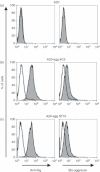Presentation of the candidate rheumatoid arthritis autoantigen aggrecan by antigen-specific B cells induces enhanced CD4(+) T helper type 1 subset differentiation
- PMID: 22182481
- PMCID: PMC3372749
- DOI: 10.1111/j.1365-2567.2011.03548.x
Presentation of the candidate rheumatoid arthritis autoantigen aggrecan by antigen-specific B cells induces enhanced CD4(+) T helper type 1 subset differentiation
Abstract
Effective immune responses require antigen uptake by antigen-presenting cells (APC), followed by controlled endocytic proteolysis resulting in the generation of antigen-derived peptide fragments that associate with intracellular MHC class II molecules. The resultant peptide-MHC class II complexes then move to the APC surface where they activate CD4(+) T cells. Dendritic cells (DC), macrophages and B cells act as efficient APC. In many settings, including the T helper type 1 (Th1) -dependent, proteoglycan-induced arthritis model of rheumatoid arthritis, accumulating evidence demonstrates that antigen presentation by B cells is required for optimal CD4(+) T cell activation. The reasons behind this however, remain unclear. In this study we have compared the activation of CD4(+) T cells specific for the proteoglycan aggrecan following antigen presentation by DC, macrophages and B cells. We show that aggrecan-specific B cells are equally efficient APC as DC and macrophages and use similar intracellular antigen-processing pathways. Importantly, we also show that antigen presentation by aggrecan-specific B cells to TCR transgenic CD4(+) T cells results in enhanced CD4(+) T cell interferon-γ production and Th1 effector sub-set differentiation compared with that seen with DC. We conclude that preferential CD4(+) Th1 differentiation may define the requirement for B cell APC function in both proteoglycan-induced arthritis and rheumatoid arthritis.
© 2011 The Authors. Immunology © 2011 Blackwell Publishing Ltd.
Figures






Similar articles
-
Antigen-specific B lymphocytes acquire proteoglycan aggrecan from cartilage extracellular matrix resulting in antigen presentation and CD4+ T-cell activation.Immunology. 2014 Jan;141(1):70-8. doi: 10.1111/imm.12169. Immunology. 2014. PMID: 24032649 Free PMC article.
-
Role of antigen-presenting cells in the polarized development of helper T cell subsets: evidence for differential cytokine production by Th0 cells in response to antigen presentation by B cells and macrophages.Eur J Immunol. 1994 Oct;24(10):2506-14. doi: 10.1002/eji.1830241037. Eur J Immunol. 1994. PMID: 7925578
-
Unconventional T-cell recognition of an arthritogenic epitope of proteoglycan aggrecan released from degrading cartilage.Immunology. 2016 Apr;147(4):389-98. doi: 10.1111/imm.12557. Epub 2015 Dec 21. Immunology. 2016. PMID: 26581676 Free PMC article.
-
Dendritic cells, T cells and their interaction in rheumatoid arthritis.Clin Exp Immunol. 2019 Apr;196(1):12-27. doi: 10.1111/cei.13256. Epub 2019 Jan 21. Clin Exp Immunol. 2019. PMID: 30589082 Free PMC article. Review.
-
Antigen processing and presentation by epidermal Langerhans cells. Induction of immunity or unresponsiveness.Dermatol Clin. 1990 Oct;8(4):633-47. Dermatol Clin. 1990. PMID: 1979019 Review.
Cited by
-
B cells contribute to heterogeneity of IL-17 producing cells in rheumatoid arthritis and healthy controls.PLoS One. 2013 Dec 5;8(12):e82580. doi: 10.1371/journal.pone.0082580. eCollection 2013. PLoS One. 2013. PMID: 24340045 Free PMC article. Clinical Trial.
-
Relationship Between a Vitamin D Genetic Risk Score and Autoantibodies Among First-Degree Relatives of Probands With Rheumatoid Arthritis and Systemic Lupus Erythematosus.Front Immunol. 2022 Jun 3;13:881332. doi: 10.3389/fimmu.2022.881332. eCollection 2022. Front Immunol. 2022. PMID: 35720397 Free PMC article.
-
Regulation of B lymphocytes and plasma cells by innate immune mechanisms and stromal cells in rheumatoid arthritis.Expert Rev Clin Immunol. 2014 Jun;10(6):747-62. doi: 10.1586/1744666X.2014.907744. Epub 2014 Apr 16. Expert Rev Clin Immunol. 2014. PMID: 24734886 Free PMC article. Review.
-
Antigen-specific B lymphocytes acquire proteoglycan aggrecan from cartilage extracellular matrix resulting in antigen presentation and CD4+ T-cell activation.Immunology. 2014 Jan;141(1):70-8. doi: 10.1111/imm.12169. Immunology. 2014. PMID: 24032649 Free PMC article.
-
Interleukin-9 and T helper type 9 cells in rheumatic diseases.Clin Exp Immunol. 2016 Aug;185(2):125-32. doi: 10.1111/cei.12807. Clin Exp Immunol. 2016. PMID: 27159882 Free PMC article. Review.
References
Publication types
MeSH terms
Substances
Grants and funding
LinkOut - more resources
Full Text Sources
Medical
Research Materials

